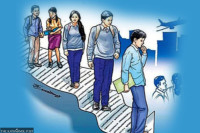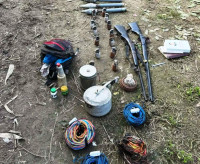National
Despite pre-election clashes, polls may pass relatively peacefully, observers say
Police say as many as 62 cases of clashes have been reported between April 24 and Tuesday, May 10, but expect violence to subside with the silent period in force.
Binod Ghimire
On May 2, CPN (Maoist Centre) cadres clashed with those from the CPN-UML and Nepali Congress at Putha Uttarganga Rural Municipality ward-11 in Rukum East, leaving six people injured. A woman, who was a supporter of the UML-Congress alliance, went missing. The alliance accused the Maoist Centre of abducting her. After eight days, on Tuesday, the body of Junmaya (Dhunthi) Budha was found in a jungle within the rural municipality.
Police have arrested three people including the immediate past ward chairperson Jaya Kumar Budha, who is seeking a new term, in connection with the incident.
While the Congress has formed an electoral alliance with the Maoist Centre and other parties in the rest of the country, it has joined hands with the UML in Rukum East and Rolpa, among other districts.
“Three supporters of the Maoist Centre have been arrested for investigation based on a complaint from the victim’s family,” Hira Lal Acharya, assistant chief district officer of Rukum East, told the Post on the phone. “The arrested are being investigated.”
The country is holding local elections on Friday in a single phase across the country. Since the Netra Bikram Chand-led armed outfit, the Communist Party of Nepal, and a secessionist movement leader in the Tarai, CK Raut, have already signed peace deals with the government in March 2021 and March 2019, respectively, now the major security threat during the elections is from the mainstream political parties, security officials told the Post last month.
A number of clashes were reported on Tuesday alone, the last day for electioneering before the start of the silent period.
At least six people including four police personnel were injured in a clash between the UML and Congress cadres during a door-to-door campaign in Simta Rural Municipality, Surkhet. The two sides started clashing when they ran across each other on the campaign trail. Similarly, a ward chairperson candidate from the UML in Duhun Rural Municipality Ward 6, Darchula got injured in a clash. Man Singh Badal got hurt along with three others from the UML in another clash with Congress cadres.
“Several cases of election-related clashes have been reported in the last two weeks,” Senior Superintendent Bishnu Kumar KC, spokesperson for the Nepal Police, told the Post.
A report of the Nepal Police shows as many as 62 cases of clashes have been reported between April 24 and Tuesday. The most number of incidents—24—were reported from Karnali Province. Police have arrested 43 people for their alleged involvement in inciting violence.
Kapil Shrestha, chairperson of the National Election Observation Committee, said there are reports of confrontations during electioneering in all provinces.
“Clashes are natural when the top leaders from various parties themselves are competing with each other in making inciting and provocative speeches,” he told the Post. “We hope clashes will come down from today [Wednesday] as the silent period has already begun.”
The Election Commission has imposed complete restrictions on all forms of physical and virtual canvassing from Tuesday midnight.
Observers say despite clashes in the lead up to the elections, voting is likely to pass relatively peacefully this time.
When Nepal held the last elections in 2017, some small parties and armed outfits were active.
The Chand-led Communist Party of Nepal, which threatened candidates and voters in the previous election, is itself contesting polls this time. Since the party was not registered with the Election Commission, its candidates are running independently.
CK Raut, who was leading a secessionist campaign five years ago, has formed his political party—Janamat Party. It was the first party to register with the Election Commission for Friday’s local elections. It has fielded candidates in more than 100 local units.
“Unlike in the past, there is no threat of underground forces or armed outfits this time. The real challenge is clashes and infighting within the parties contesting the elections,” Pradip Pokharel, chairperson of the Election Observation Committee, Nepal, told the Post. “While most clashes are between the UML and the parties in the ruling alliance, there are reports of fighting and clashes between the parties within the ruling alliance.”
Security agencies too had assessed that rifts in the parties fighting elections would be the biggest challenge in the local elections.
Talking to the Post on April 5, Fanindra Mani Pokharel, spokesperson for the Ministry of Home Affairs, had said intra-party rifts and conflicts in parties could be the biggest threat during the upcoming elections.
Observers say although the election campaigning has stopped with the silent period coming into force, possibility of clashes cannot be fully ruled out.
“Parties will be making final efforts to woo voters even during the silent period and also on the election day, and this can prompt clashes,” said Pokharel. “The Election Commission, security forces and even the election observers must remain vigilant.”




 19.12°C Kathmandu
19.12°C Kathmandu

%20(1).jpg&w=200&height=120)













